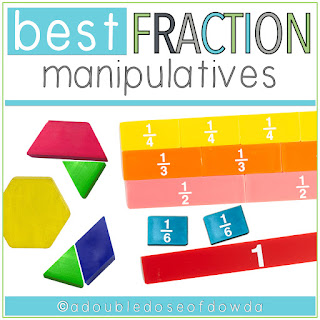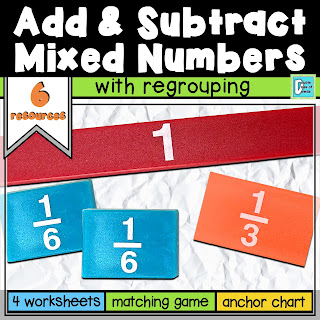Looking for how to introduce and teach adding and subtracting mixed numbers?
Let’s talk about using manipulatives, pictures, and algorithms - plus how to regroup fractions and differentiate instruction for students when they add and subtract mixed numbers.What to look for in this post:
- The progression of the standards for adding and subtracting mixed numbers
- Teaching using the CRA Model
- Demonstrating addition of mixed numbers with manipulatives
- Demonstrating subtraction of mixed numbers with manipulatives
- Representational modeling of adding and subtracting mixed numbers
- Teaching the algorithm for adding and subtracting mixed numbers
- Milestones for adding and subtracting mixed numbers
- Differentiation for adding and subtracting mixed numbers
[0:32] The progression of the standards for adding and subtracting mixed numbers
In third grade, students learn basic fractions. They learn to identify and compare fractions, as well as about equivalent fractions. In most states, fourth grade students learn to add and subtract fractions with like denominators. In fifth grade, they learn how to add and subtract fractions with unlike denominators, including mixed numbers.After fifth grade, students are expected to have a firm understanding of adding and subtracting fractions. Starting in third grade, we can provide them with a strong foundation to support fraction knowledge moving forward.
[1:36] Teaching using the CRA Model
Whenever we teach something, we certainly want to take a research-based approach. In this case, we can use the CRA model. Students first learn something in a concrete way, through hands-on experience and exposure. They might use manipulatives to help them understand a new concept.Then, students learn to represent the concept through pictures. Finally, they learn to use the abstract equations and algorithms.
For the purposes of teaching addition and subtraction of mixed numbers, we can use pattern blocks and fraction bars as concrete models. For representational, we will be using pictures and number lines. For abstract, we will use written equations.
Students need time to work through each of these models. Some of them may be ready to jump to representational or even abstract models more quickly than others, but I encourage you to make sure they all start with concrete modeling.
[3:21] Demonstrating addition of mixed numbers with manipulatives
To see the full demonstration, check out the YouTube video and move to the time stamp noted above.As I have shared in previous posts, I absolutely love fraction bars, also called fraction tiles, as well as pattern blocks for all things fractions. You can have students work in pairs or small groups. When using manipulatives, I limit the amount of writing of equations I do. I want students to be able to see things without becoming too distracted. At this point, however, students should be quite familiar and proficient with adding and subtracting fractions with like denominators and unlike denominators. So if you need to review those things with them first, by all means do that.
As an example, we can write the equation: 2 ⅚ + 1 ⅓
Using the pattern blocks, we can assemble a concrete model of the equation. Instead of focusing on the whole numbers, I tell students to focus on the fraction pieces: ⅚ and ⅓. I am going to want to combine those pieces, so I need to get them to be the same size pieces. Hopefully, they come up with the idea to change the third to sixths - and because they are familiar with fractions they should know pretty quickly that ⅓ = 2/6.
At this point, I would rewrite the equation under the original: 2 ⅚ + 1 2/6
Sometimes I put an arrow from the mixed number I changed to its new number, so students recognize that is the one that changed.
2 + 1 is three wholes, so we can show that using the pattern blocks. When we combine ⅚ and 2/6, we get an additional 1 whole and ⅙. I have them physically write out 3 + 1 ⅙ and then I ask them what swap we can make. We could also write it as 3 + 7/6 or 3 + 6/6 + ⅙. The total is 4 ⅙.
[10:01] Demonstrating subtraction of mixed numbers with manipulatives
To see the full demonstration, check out the YouTube video and move to the time stamp noted above.First, I would advise doing more simple subtraction with mixed number problems that do not require regrouping. For the purpose of this demonstration, we are going to jump right into a problem that involves regrouping.
We can write the equation: 2 ⅙ - 1 ⅓
We are going to start by building 2 ⅙ with our blocks. I suspect students would think that taking away 1 whole is easy, but the difficult part is taking away ⅓ from 2/6. Again, we need to get to the same size pieces with these fractions. Students may want to swap out for thirds, but that will become troublesome in the next step. Listen to that idea, but ask them if there is something else they could do.
The first time through, it may be helpful for you to just tell them the answer. Let’s make everything into sixths. Swap out our wholes for six sixths, and what do we have? 2 ⅙ becomes 13/6.
Now we need to take away 1 ⅓ - which we can turn into 8/6. Now we can subtract 8/6 from 13/6. We have two improper fractions with like denominators, so we can do simple subtraction and reach the answer of ⅚.
It can be difficult to go through these steps as teachers, because we may want to jump straight to the algorithm. That is not, however, what is most appropriate for students. They need to work with concrete models and truly see what is happening.
[15:51] Representational modeling of adding and subtracting mixed numbers
To see the full demonstration, check out the YouTube video and move to the time stamp noted above.We can start with another equation: 1 ⅙ + 1 ⅓
When we move to representational modeling, I still like students to have their manipulatives at hand. In this case, I’m going to use pictures rather than a number line. Sometimes problems can get a little bit messy, and students are not always great at drawing their own number lines. Using pictures can help to provide more clarity. Students can trace their pattern blocks, and color the various fractions.
We will then re-write the equation: 1 ⅙ + 1 2/6
When we see that the answer is 2 3/6, we can ask them to put it in simplest form. They should recognize that 3/6 = ½ so the answer would be 2 ½.
Drawing this out helps students to better understand the concept as they get into the abstract algorithm. We don’t want them to live here forever, but some students may take longer here and need to draw things out. We want to provide that opportunity so they can bridge their learning as they go along.
[21:30] Teaching the algorithm for adding and subtracting mixed numbers
To see the full demonstration, check out the YouTube video and move to the time stamp noted above.Working through a problem we previously did with pattern blocks, the equation is:
2 ⅙ - 1 ⅓
For the algorithm, you will teach the students with a shortcut to multiply the denominator by the whole number, and then add the numerator. Using this method, the equation becomes:
13/6 - 4/3
In order to subtract this equation, we need an equivalent fraction.
13/6 - 8/6 = 5/6
[23:35] Milestones for adding and subtracting mixed numbers
I always like to keep the milestones in mind when I am teaching. What are the big pieces that I need to make sure that students are solid on? This can help me to pinpoint what part of the process they are having trouble in.For adding and subtracting mixed numbers, we want to make sure that students can use least common multiples to develop their least common denominators.
Students need to really understand equivalent fractions.
With mixed numbers, students need to be able to regroup and write the fractions in a different way.
We need to make sure that students are clear that they only add and subtract the numerators - the denominators stay the same.
Lastly, we want to be sure that they understand simplest form. Students often struggle to put their answers in simplest form.
When we break things down this way, it helps us plan our instruction.
[25:01] Differentiation for adding and subtracting mixed numbers
For struggling students, you may want to review adding and subtracting fractions with like denominators and creating equivalent fractions. When we work with mixed numbers, it is also important to make sure students can regroup.If you have students who need a bit of a challenge, you can have them add and subtract three mixed numbers. You can also start to combine adding fractions and decimals.
Looking for more resources for teaching how to add and subtract mixed numbers?
When it comes to practicing these skills, I have put together a bundle of some of my favorite activities for adding and subtracting mixed numbers (including regrouping). It includes six resources:- Four maze worksheets
- One matching game
- One anchor chart
The Activities Bundle is available on Teachers Pay Teachers.
Check out these related posts:
How to Teach Adding and Subtracting Fractions with Like Denominators
How to Teach Adding and Subtracting Fractions with Unlike Denominators
How to Teach Metric Measurement for Third Grade
How to Teach Metric Conversions for Fourth and Fifth Grades
Check out these related YouTube videos:
How to Teach Adding and Subtracting Fractions with Like Denominators
How to Teach Adding and Subtracting Fractions with Unlike Denominators
How to Teach Third Grade Measurement
How to Teach Converting Measurements for Fourth and Fifth Grades
How to Teach Polygons and Quadrilaterals for Third Grade





No comments
Post a Comment